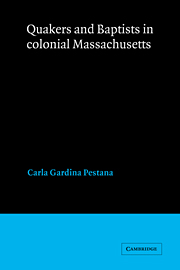2 - A “pretended church” in Charlestown and Boston
Published online by Cambridge University Press: 22 October 2009
Summary
Even as the spirited confrontation between the Salem Quakers and the defenders of orthodoxy was slackening, a second sect was struggling to gain a foothold in Massachusetts Bay. A small group of baptized believers gathered a church in Charlestown in 1665. With this act, Anabaptist agitation in the colony – which had traditionally been diffused and sporadic – became focused and sustained. In a continuation of this tradition and in marked contrast to the localistic nature of the Quaker movement, Baptist converts lived scattered throughout many colonial towns. As had been the case in the years before 1665, those who favored the Baptist faith remained intimately engaged in issues of importance to the orthodox faith.
The position of this new church was not as precarious as that of the Quaker meeting had initially been. The presence of Quakers in the colony as well as the monarch's well-known opposition to severe persecution forestalled a similarly vicious effort to suppress the Baptist church. In addition, this second movement had greater credibility than Quakerism, because of both the people who joined and the views they advocated. Despite the relative advantages enjoyed by the Baptists and the recent failure of efforts to crush the Quaker movement, the authorities labored to prevent the creation and growth of a Baptist church in the colony. By the early 1670s, their efforts had failed.
At about two o'clock on the afternoon of 7 March 1668/9, nineteen people met in the Charlestown home of wheelwright and farmer Thomas Goold to worship the Lord.
- Type
- Chapter
- Information
- Quakers and Baptists in Colonial Massachusetts , pp. 44 - 62Publisher: Cambridge University PressPrint publication year: 1991



